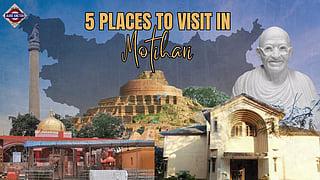
The village of Chandrahiya is located in Bihar's East Champaran district. Chandrahiya continues to hold a special place in the Champaran movement. On April 16, 1917, Gandhi stopped in this village on his way to the hamlet of Jasaulipatti to hear the grievances of the farmers who were being forced to grow indigo instead of food crops.
Gandhi had received a warning from then-Champaran collector WB Heycock ordering him to leave the district's boundaries immediately from a police officer riding a horse-drawn buggy. Gandhi ji had obeyed and taken a bullock cart back to Motihari. He refused to leave Champaran, however, and two days later appeared in the court of the sub-divisional magistrate to clarify his position, starting the Champaran satyagraha.
A holy city in North Bihar called Areraj is situated 28 km on Pucca Road southwest of Motihari. Millions of people from neighbouring districts and Nepal flock to the famous Someshwar Nath Mahadev Temple during the Shravan Mela (July–August). The settlement of Areraj has developed into the Areraj Subdivision's administrative hub.
On the left side of the Areraj - Bettiah highway is an imposing stone column, which Priyadarshee Lord Ashok constructed in 249 BC near the village Lauriya in the Areraj subdivision. The "Stambh dharm-like" pillar is a single polished sandstone block that rises 36 12 feet above the ground and has a base diameter of 41.8 inches and a top diameter of 37.6 inches. It carries six of his edicts in beautifully preserved and precisely cut calligraphy. Despite only weighing in at about 34 tonnes, this portion must extend deep into the soil. The block must be about 40 tonnes in weight overall.
According to the Archaeological Survey of India, the Ashokan Pillar is a protected monument.
The then-Governor, Mr D.K. Barooch, laid the cornerstone for this Gandhi memorial pillar on June 10, 1972, and a Gandhian named Mr Vidyakar Kavi dedicated it to the nation on April 18, 1978. This memorial pillar was built by well-known Santiniketan artist Mr Nand lal Bose in remembrance of Champaran Satyagraha, a close friend of Mahatma Gandhi who was the first to speak out against the wrongs done by British indigo planters to the underprivileged Champaran peasants. On April 18, 1917, in defiance of orders issued under Section 144 of the Criminal Procedure Code, Mahatma Gandhi was brought before the court of the then-S.D.M., Motihari, where the 48-foot-long Chunar stone pillar now stands. Champaran was the starting point for Satyagraha since Mahatma Gandhi tested it on this Motihari land there.
With the discovery of the "largest ever Buddhist Stupa" at Kesaria in the East Champaran district, some 120 kilometres from Patna and 30 miles from Vaishali on the Indo-Nepal border, Bihar's historical significance has been restored. The Archaeological Survey Team of India In 1998, after digging, authorities discovered this Stupa. Officials from ASI claim that Bihar is pleased to be home to the highest Stupa to have ever been unearthed. A turning point in India's conservation history has been reached with the preservation of Kesaria Stupa.
At Kesaria, Lord Buddha spent his last voyage atop a majestic height. Here, he delivered impressive proclamations that were subsequently written down in Buddhist Jatak - Story. At Kesaria, the Buddha declared that he had previously been the ruler of Chakravarti Raja. Buddha then gave them the "BEGGING BOWL" and instructed Licchivis to go back to Vaishali.
